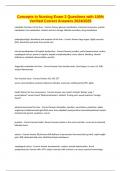Concepts in Nursing Exam 2 Questions with 100%
Verified Correct Answers 2024/2025
metabolic functions of the liver - Correct Answer glucose metabolism, ammonia conversion, protein
metabolism, fat metabolism, vitamin and iron storage, bilirubin excretion, drug metabolism
pathophysiologic alterations and anatomy of the liver - Correct Answer large organ, highly vascular,
RUQ, blood flow primarily from portal vein
clincial manifestations of hepatic dysfunction - Correct Answer jaundice, portal hypertension, ascites,
esophageal varices, prone to rupture, hepatic encephalopathy, coma, edema, bleeding, vitamin
deficiency, metabolic abnormalities, pruritis.
diagnostic evaluations for liver - Correct Answer liver function tests, liver biopsy, ct scans, US, MRI,
surgical laparoscopy
liver function tests - Correct Answer ALT, AST, GTT
serum concentrations: proteins (albumin, bilirubin, ammonia, clotting factors(PT), lipids
health history for liver assessment - Correct Answer new meds? herbals? dietary supp.?
prescriptions? recent travel? lifestyle behaviors? alcohol? IV drug use? sexual practices? foreign
travel?
physical assessment for liver - Correct Answer skin(pallor, jaundice, excoriations, petechiae, spider
angiomona) abdomen(enlarged,fluid wave, liver palpable) eyes(jaundice) extremities(edema) mental
state(slurred speach, weakness, coma)
jaundice - Correct Answer body's tissues become yellow in the sclera and skin. occurs do to elevated
bilirubin levels
ascites - Correct Answer (fluid wave shift-dullness in percussion) increased abd. growth, rapid weight
gain, SOB, distended abd veins, fluid/electrolyte imbalances
esophageal varices - Correct Answer hematemesis, melena, mental deterioration, shock
symptoms(cool, clammy skin, HTN, tachy) common with cirrhosis, can cause massive hemorrhage
, hepatic encephalopathy and coma - Correct Answer mental status changes, motor disturbances,
drowsy in day, restless at night, disorientation, hyperactive deep tendon reflexes to flaccid. life
threatening, occurs with profound liver failure
portal hypertension - Correct Answer splenomegaly+hypersplenism, ascites and varices, commonly
associated with cirrhosis
nutritional deficiencies - Correct Answer A-night blindness,eye,skin change. C-hemorrhagic lesions of
scurvy. K-hypoprothrombinemia,spontaneous bleeding. folic acid-macrocytic anemia.Thiamine-
beriberi,polyneuritis,wernicke-korsakoff psychosis. Riboflavin-characteristic skin/mucous membrane
lessions. Pyridoxine-same as above/neurologic changes
medical management of pt with esophageal varices - Correct Answer pharmacologic-vasoactive
drugs/beta blockers. balloon tamponade, endoscopic sclerotherapy, endoscopic variceal
ligation(banding therapy) TIPS
surgical management of pt with esophageal varices - Correct Answer surgical bypass procedures,
devascularization/transection
nursing management of pt with esophageal varices - Correct Answer observe response to therapy,
watch for side effects, support, explain, oral hygeine, observe for aspiration, bleeding, signs of
infection, perforation, altered mental state.
Hepatitis A causes/prevention - Correct Answer fecal-oral route, contaminated food or water, poor
hygiene, hand to mouth, sexual activity. crowded areas, poor sanitation.
hepatitis A manifestations - Correct Answer many without symptoms/most recover. mild,flu-like,low
grade fever,anorexia,indigestion,jaundice
Hepatitis A management - Correct Answer bed rest, IV fluids, nutritious diet, educate pt, alcohol
avoidance, personal hygiene practices, routine labs
Hepatitis B causes/prevention - Correct Answer blood,saliva,semen,vaginal secretions. mucous
membranes, breaks in skin, mother to infants. most recover spontaneously after 6 months




